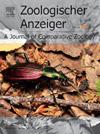Kinomenclature: An analysis of scientific names of mud dragons (Kinorhyncha)
IF 1.5
3区 生物学
Q2 ZOOLOGY
引用次数: 0
Abstract
The coining of new species names is one of the most creative processes in science. Scientific names must be unique and stable over time to allow researchers to communicate knowledge on species unambiguously worldwide. Despite the importance of biological nomenclature, few studies analyze nomenclatural trends, which can offer interesting information. In the present paper, we explore different trends in naming Kinorhyncha species over time to answer questions related to kinorhynch nomenclatural acts, compare trends among the different specialists and discuss possible suggestions for future species discoveries. We focus on detecting the main practices followed by the phylum specialists when coining new specific names, temporal trends in the used language and etymological basis for creating the names and differences between author preferences. It is interesting that not all Kinorhyncha names correspond to valid species, although the proportion of not accepted and uncertain names is low. On the other hand, the usage of classical languages (Latin and Greek) remains temporarily stable when coining species names, but other modern languages such as English, Spanish, Danish and Japanese are on the rise, partly due to the nationality of the current kinorhynchologists. Regarding the etymological basis, a replacement of traditional categories (morphology, geography) by eponyms has not been detected, even though the usage of the latter has significantly increased in recent years. Finally, since the creation of names is undoubtedly subjective, personal trends among the authors are obvious, each one following their own style and preferences.
术语:泥龙(Kinorhyncha)学名分析
创造新的物种名称是科学中最具创造性的过程之一。科学名称必须具有唯一性和长期稳定性,以便研究人员在全球范围内明确传播物种知识。尽管生物命名非常重要,但很少有研究对命名趋势进行分析,而这却能提供有趣的信息。在本文中,我们探讨了随着时间的推移,Kinorhyncha物种命名的不同趋势,以回答与Kinorhynch命名行为相关的问题,比较不同专家之间的趋势,并讨论对未来物种发现的可能建议。我们的重点是发现门类专家在创造新的特定名称时所遵循的主要做法、所使用语言的时间趋势、创造名称的词源学基础以及作者偏好之间的差异。有趣的是,尽管未被接受和不确定名称的比例较低,但并非所有 Kinorhyncha 名称都与有效物种相对应。另一方面,在创造物种名称时,古典语言(拉丁语和希腊语)的使用暂时保持稳定,但其他现代语言,如英语、西班牙语、丹麦语和日语的使用却在增加,这部分是由于目前的金龙鱼学家的国籍造成的。在词源学基础方面,尽管近年来外来语地名的使用显著增加,但尚未发现外来语地名取代了传统类别(形态学、地理学)。最后,由于名称的创造无疑是主观的,因此作者之间的个人倾向也很明显,每个人都遵循自己的风格和偏好。
本文章由计算机程序翻译,如有差异,请以英文原文为准。
求助全文
约1分钟内获得全文
求助全文
来源期刊

Zoologischer Anzeiger
生物-动物学
CiteScore
2.80
自引率
7.10%
发文量
75
审稿时长
>12 weeks
期刊介绍:
Zoologischer Anzeiger - A Journal of Comparative Zoology is devoted to comparative zoology with a special emphasis on morphology, systematics, biogeography, and evolutionary biology targeting all metazoans, both modern and extinct. We also consider taxonomic submissions addressing a broader systematic and/or evolutionary context. The overall aim of the journal is to contribute to our understanding of the organismic world from an evolutionary perspective.
The journal Zoologischer Anzeiger invites suggestions for special issues. Interested parties may contact one of the editors.
 求助内容:
求助内容: 应助结果提醒方式:
应助结果提醒方式:


